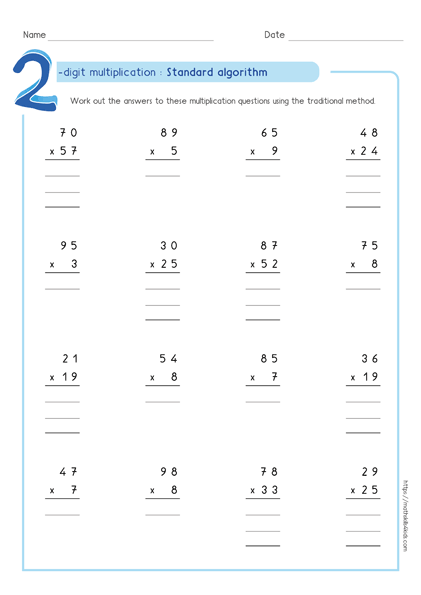
Students demonstrate vertical formats to solve. They use models to demonstrate solving two-digit by two-digit multiplication. Students explore basic algorithms for addition, subtraction, and multiplication. The Multiplier (origin of the algorithm) For Teachers 4th - 8th.
Putting down two zeros and so moving the digits by two place value columns) and then by 3 To multiply by 30, first multiply by ten (by putting down the zero) and then by 3 To multiply by 300, first multiply by one hundred (by multiplying by ten and then by ten again i.e. The basic algorithm is similar to the one used in multiplying the numbers.Multiplication by 30 is done by multiplying by 3 and then by 10 (or vice versa). We want to multiply these numbers. Formulas for Quarter Squares and Half SquaresConsider two unsigned binary numbers X and Y.
Computing the product AB takes nmp scalar multiplications n(m-1)p scalar additions for the standard matrix multiplication algorithm. Thus, AB is an n x p matrix. Complexity of Matrix Multiplication Let A be an n x m matrix, B an m x p matrix. Standard algorithm is an old and one. Amongst many multiplication methods, we also have the standard algorithm Multiplication Worksheets PDF. Here, you multiply ones and tens separately then and each partial products to find the final answer.
Table 1: Babylonian Quarter Squares Tables BarTa Rectangle in the Babylonian math problems Babylonian Reciprocal Algorithms with Successive Factorizations Notes on Multiplication Methods and Modern Logarithms

appendix, Golden Rectangle Dimensions for even numbered area units (burs)This page is under development. appendix : Script on Tables for TCL console Favorite Bablylonian Rectangle on Geometry Grid, includes (3-4-5)* (1/4) triangle Table 7 : Powers of 2 with added Modern Logarithm Notation
Its very hard to reply reasonably without some background of the correspondent on his WIKI bio page. Aside from your courtesy, your wiki MONIKER and date as a signature and minimal good faith of any internet post are the rules of this TCL-WIKI. Please include your wiki MONIKER and date in your comment with the same courtesy that I will give you.

Multiplication Algorithm Example Code Are Called
In Babylon, the desired end goal was usually 60 for base_60, but the algorithm steps, notation, and desired goal can be transformed into base 10, base 16, or other bases for modern schemes and computer algorithms. In modern terms, the integer number pairs in Babylonian base_60 notation that appeared on the tablet may be N,int,int, ,int, until a desired goal is reached. Zip instructions on algorithms and code are called job security in some quarters. For that matter, some modern quarter square tables and publications did not include any instructions, complete instructions, or any explanation on how the tables were generated. The bare numbers in the Babylonian multiplication tables do not tell the complete method, as there are mental and undocumented components of the Babylonian multiplication methods, meaning actions, table lookup, and calculations off the clay tablet.
In most cases, the math problem is how the coefficient was used in estimating materials, work rates, and math problems. The college institutes, textbooks, and computer companies in the USA that previously used the Babylonian mathematical ideas without credit may be glad to know that the Babylonian copyrights and patents expired about 4000 years ago.In the cuneiform math problems and coefficient lists on clay tablets, there are coefficient numbers which were used in determining the amount of materials and the daily work rates of the workers. The 2007 paper of David McFarland provided an excellent history of the quarter square multiplication algorithm in both the ancient and modern eras.
The basic dimensions and final tallies were presented in the cuneiform accounts on clay tablets, but some calculations, some units, and some problem answers (aw shucks!) were left off the tablet. For example, 20 could represent either 20*3600,20*60,20,20/60, 20/3600, or even 1/20. In cuneiform, numbers in base 60 are written on clay tablets using a notation of relative place value.

Also rearranging terms from the quarter square formulation, x*y =. But there is some uncertainty specific to how the Babylonian half square tables were used, as the tablet CBS-1535 includes integers and half fractions in base_60 notation. As an extension, the half square multiplication formula for the tables may be equivalent to x*y = 0.5* *. The quarter square multiplication formula for the tables is x*y = *.


 0 kommentar(er)
0 kommentar(er)
